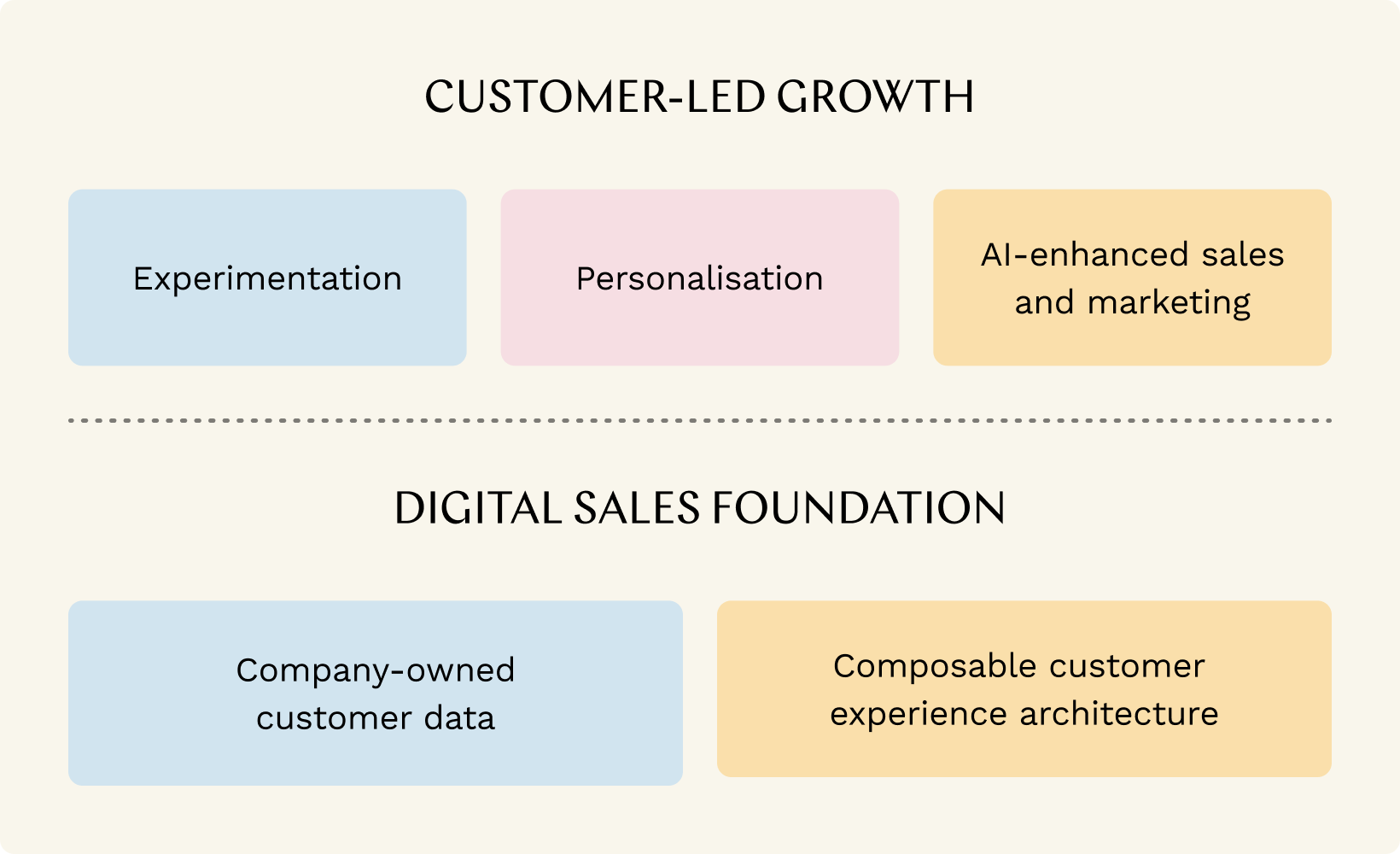Personalisation opportunity canvas
Start mapping your personalisation opportunities with this easy-to-use interactive Miro template.
Get the templateWith 2024 right around the corner, it’s time to map out the year ahead. To help you navigate around the most significant trends in the world of digital commerce, we asked our experts to give their predictions on the future of digital commerce.
Here are five trends to keep on your radar:

1. Growth is customer-led in 2024
By Managing Consultant Ville Sillanpää, General Manager Simon Fransson, and Managing Partner Eero Martela
Growth hacking and conversion rate optimisation – you’ve certainly heard of these buzzwords in recent years. While some of the principles are evergreen, typically, these are seen as tactical grass-root-level activities. Having talked to numerous digital sales leaders, many are looking at broader horizons, or in other words, holistic online experimentation. The key question in their minds going into 2024 is: “How can we optimise the customer experience throughout the sales funnel for sales, retention, and, ultimately, higher customer lifetime value?”
What’s stopping companies from getting tangible results is that they are not testing enough, or they aren’t testing wide and big enough – combined with a lack of understanding of who the customer is and what is their actual experience. This has led to a gap between what companies think they offer their customers and the actual customer experience. You might believe your customers have a smooth buying experience when, in reality, they might experience frustration at multiple points of the process, making you miss out on sales and loyalty.
In 2024, the recipe for growth is this: rapid data-driven experimentation across all touchpoints. However, doing synchronised commercial operations across organisational siloes is not easy. What we have seen to be successful is to, in all occasions, start from the customer. The objective is to continuously provide more value to the customer at each touchpoint. This is what we like to call customer-led growth.
2. Have your customer data in check
By General Manager Ville Loppinen
In 2024, everything once again comes back to customer data. Customer data is the fuel for customer-led growth. It’s the raw material you need for AI applications and the prerequisite for any personalisation efforts. Knowing your customers and having well-structured and enriched customer data will be a key competitive advantage in 2024.
Especially company-owned customer data is becoming increasingly important. In 2024, customer data goes beyond just customer profiles; it also includes purchase and behaviour data, as well as predictive data. Having rich customer data can open new opportunities to scale and expand your business. The importance of customer-owned data is further increased with customers’ privacy concerns and stricter privacy regulations. Having the customers’ permission for marketing is a more valuable asset than ever. Once you have a solid customer base and the ability to market and sell to them, you can expand to new offering areas, growing through your existing customer base.
Moreover, as companies are looking into concrete ways to utilise AI in marketing and sales operations, many will realise that the only thing holding them back is the quality, quantity and structure of their customer data. As mentioned above, customer data is also the prerequisite for personalisation. Personalised and seamless buyer journeys are the expectation in 2024, and they are made possible with well-structured customer data.
Luckily, data integration tools and CDP technology have taken huge steps forward during 2023, and omnichannel data integration is technically becoming much easier. The technology is mature, and there are numerous new CDP tools in the market – Salesforce Data Cloud being one, that has shifted the landscape in the last year.
3. Get the most out of your composable customer experience architecture
By Managing Consultant Matti Liski, Managing Consultant Lauri Larjo, and Senior Consultant Sami Taipale
Composable commerce was one of the greatest trends in the world of ecommerce in 2023. As more and more companies are replacing their monolithic ecommerce platforms with composable MACH-connected digital commerce architectures, we see that trend continuing on into 2024.
The development in the world of composable commerce has been significant in the last year. You can now press live on your new store faster than ever, in just months even as a larger corporation. Different plug-and-play features work more smoothly together than ever before and with fairly low effort.
As the composable solutions have undergone major developmental leaps in 2023, it’s smart to keep your eyes open to new features and possibilities your existing tech stack has to offer. Perhaps the search tool you’ve used now offers personalisation features, or your headless CMS offers better content orchestration or visual editing features. Before plugging in new tools in 2024, ensure you’re utilising all your current stack has to offer.
As more and more ecommerce tech stacks are built with separate composable products with their own pricing model, cost management will look different in 2024. Moreover, composable commerce begs for new kinds of professionals. You’ll need experts who understand the entire ecosystem and have a strong know-how of building holistic customer experiences instead of having experts specialised solely in one monolith.
4. Leap into personalisation
By Managing Consultant Juuli Kiiskinen
In unpredictable markets, it is more important than ever to look after your existing customers rather than emphasising the attraction of new ones. If the market trend remains the same, people will continue to be extra careful about their spending. Trust, relevance, and price will persist as core drivers in the relationship between businesses and consumers.
Personalisation has been a topic of discussion among big consultancies like McKinsey, Deloitte and Accenture in the last year. The biggest platforms in the industry have also validated its importance – Salesforce and HubSpot being some. As all big players are betting on personalisation, it begs the question: “Why wouldn’t you?”
Everything needed for personalisation already exists: the tools, the data, and the processes developed by experimentation teams. Even AI is now accessible to everyone and can significantly boost the impact of personalisation if used correctly – as we will demonstrate next.
What is still lacking as we go into 2024 is the go-ahead, the big leap to actually start investing in personalisation and setting up a team to drive it forward on a large scale.
One reason for this might be the overwhelming complexity of personalisation and how it should be driven forward. However, this can be tackled by starting small and focusing on smaller aspects of personalisation before scaling it across every touchpoint a customer encounters. Watch this presentation by Eero Martela to understand how.
The race is on, and based on what we’ve seen this year, we expect companies to take the first steps towards personalisation on a large scale in the form of creating a vision for what personalisation means in their context.
5. Accelerate productivity and personalisation with AI
By Consultants Antti Lassila and Paula Malka
In the landscape of digital sales, 2024 is expected to be characterised by ongoing advancements in artificial intelligence. Building on the momentum of 2023, when generative AI took centre stage, generative AI will continue growing particularly in the sales and marketing domain. McKinsey estimates that 25% of the total value generated by Gen AI will come from marketing and sales applications.
The opportunities for AI in digital commerce will centre around personalisation and productivity gains. We have recognised content generation, smart customer journeys, conversational interfaces, and process automation as key AI use cases that will benefit businesses in the sales and marketing arena over the next five years. For instance, website content creation, SEO, social media and ad copies, and personalised emails are all functions in content generation that will greatly benefit from AI.
With new AI-powered tools, the digital commerce sector will experience a transformative shift. For example, we have seen that major players like HubSpot and Salesforce have already unveiled glimpses of their AI-centric roadmaps for the coming year. These plans suggest significant enhancements in their platform functionalities, making AI more user-friendly and easily accessible for sales, marketing, and service operations.
However, with AI becoming a focal point, the importance of responsible usage becomes increasingly significant. The year 2024 will witness a surge in AI regulations, with the European Commission proposing a common regulatory framework, the AI Act. This legislation aims to establish a common legal framework for AI, categorising applications based on their risk and guiding ethical AI use. Regulations specific to Generative AI are also anticipated.
In light of these developments, companies must proactively reassess their business models and organisational structures, navigating the dual landscapes of AI opportunities and potential pitfalls. The digital sales arena in 2024 demands not only innovation but a strategic alignment with the evolving AI landscape.
Personalisation Opportunity Canvas
Identify opportunities to offer personalised experiences for your customers with this template.
Get the canvas



